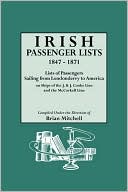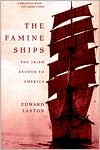Ireland
° Ireland:
° Belfast
° Giant's Causeway
° Bristol
° Cork
° Dublin ° Fallmore and Blacksod ° Galway
° Limerick
° Londonderry
° Queenstown
° Rosslare
° Waterford
° Home Rule in Ireland
° Irish in America
Belfast
In 1177 an Englishman called John de Courcy built a castle in the area, however, the actual town of Belfast grew up after 1609 when king James began his policy of settling Englishmen and Scots in Ulster. Sir Arthur Chichester was granted land in Ulster including Belfast Castle, which he rebuilt in 1611. A small town soon grew up in its shadow and by 1611 there were Englishmen, Scots and Manxmen living in the thriving community of Belfast. In 1613 Belfast was made a corporation and afterwards it sent 2 MPs to parliament. However, ordinary people had no part in the government of the town.
 |
| Belfast. 1851. John Tallis |
In the early 17th century Belfast was a small town with a population of only about 1,000 but it was busy. Wool, hides, grain, butter and salted meat were exported from Belfast to England, Scotland and France. Wine and fruit were imported into Belfast from France and Spain. Later in the 17th century Belfast traded with the North American colonies and tobacco was imported, along with sugar from the West Indies. By the late 17th century Belfast probably had a population of about 1,500-2,000, greatly due to an influx of French Protestants, fleeing religious persecution in their own country; they introduced linen weaving to Belfast. Other industries in Belfast were brewing, rope making and sail making.
In 1680 Belfast gained a piped water supply (using wooden pipes). After 1686 each householder was supposed to hang a lantern outside his house at night during the winter months.
 |
| High Street, Belfast, Northern Ireland |
In the 18th century Belfast grew rapidly, from 2,500 in 1700 to about 8,000 in 1750 and 13,000 by 1780. By 1800 Belfast had a population of around 20,000. In the late 18th century a new suburb grew up across the Lagan. Belfast gained its first newspaper in 1737. During the 18th century increasing amounts of linen, woven in people's homes, not factories, were exported from Belfast. In 1701 less than 200,000 yards of linen was exported from Belfast. By 1773 the figure had risen to 17 million yards. The White Linen Hall was built in 1788. Cotton spinning was introduced into Belfast in 1777. However it never had the same importance as linen. In 1785 a Harbour Board and shipbuilding began in Belfast in 1791.
Belfast continued to grow rapidly in the 19th century; with the industrialization of Belfast and the recurring rural famines of the early 1800s, both the Pound Street and the Sandy Row districts grew rapidly. By 1854, they totalled some 20,000 inhabitants. The population, composed almost exclusive of members of the labouring and artisan classes, depended for its livelihood primarily on the numerous linen mills and factories in the vicinity. Narrow streets and small houses characterized both districts; overcrowded conditions set the stage for trouble. While the Protestant sector was slightly more populated, Catholic inhabitants of the Pound were increasing at a far more rapid rate. The Catholic community in the Pound had more than doubled in the 12 years prior to 1857.
On July 12 1857, both districts seemed calmer than usual until . . .
 |
The Riots in Belfast. 1886. |
July 25, 1857, The Illustrated Times. London, Middlesex, United Kingdom
RIOTS IN BELFAST. - Orange ism has broken out into angry effervescence under the influence of the 12th of July. At Belfast there were riots nightly. The operations of the rioters appear to been as follows. A number met together in a field (if possible behind a ditch or embankment), having previously supplied themselves with missiles in the shape of brick-bats, "pavers," and some with more genteel, but more deadly weapons, pistols and guns. Another parity was then organised, who moved out into the open field, or took up a sheltered position like their opponents, and then commenced a regular fight brickbats, stones, and outlets whizzing through the air, until the constabulary came up, whom the contending parties then joined their forces to attack. These disturbances became at length so serious, that the military was called out to clear the streets, which was not done without great difficulty, nor until the soldiers had pricked some of the most refractory with their bayonets. On Sunday night affairs looked very critical. The rioters again assembled, and a girl received a most dangerous gunshot wound over her left eye; another was wounded in the right side, and a boy received a ball through his leg. The Riot Act was several times read; and, as the mobs did not separate, the stipendiary magistrate (Mr. Tracy) ordered all the constabulary to load. The military had all their pieces already loaded. Next came the order, "make ready," but the magistrate humanely addressed the rioters, and his advice, in conjunction with the appearance of the military and constabulary, had a good effect. The mobs disappeared, and stone throwing and gun discharges ceased.
The Harbour Commissioners Office was built in 1854. The Custom House was built in 1857. Ulster Hall was built in 1862. As in all early 19th century cities, conditions in Belfast in the years 1800-1850 were appalling. Streets were dirty and houses were overcrowded and Belfast suffered through an outbreak of typhus (a disease spread by lice) followed by cholera struck Belfast. In the late 1880s and early 1890s Belfast Council built a network of sewers. Albert Bridge was built in 1890.
 |
| The South Yard Harland and Wolff's Shipyard. Belfast. |
The shipbuilding industry in Belfast boomed. The Harland and Wolff shipyard was founded in 1862. The port also boomed. The River Lagan was shallow and winding so in 1841 a channel was dug to by-pass one of its curves. In this way Queens Island was formed. The channel was extended in 1849 and the extension was named Victoria Channel. (Both it and Queens Island were named after the visit of Queen Victoria to Belfast in 1849). Clarendon Dock was built in 1851. Dufferin and Spencer Docks followed in 1872. York Dock was built in 1897.
Belfast became a city in 1888.
April 12, 1895, San Francisco Call, San Francisco, California, U.S.A.
BELFAST-BUILT BOATS.
The Ship-Building Industry and the Linen Trade of the City.

Besides being known for its linen manufacture Belfast is noted as the reatest shipbuilding port in the world. The largest ships are made here, and travel to the uttermost parts of the wherever a ship may sail. The tourist who crosses the ocean in one of the magnificent White Star liners would do well to stop off a day or two in Belfast and see where the first plank was laid and the last touch of polish and paint put on. Everything pertaining to the ship is made here. Solid bars of iron and steel are cut and polished and molded into shape; huge sheets of steel are punched with holes and indentations as easily as we would prick a hole in a piece of paper with a pin; logs are sawed into planks, cabin fittings carved and polished, puffing, steaming engines and boilers made to propel the accomplished marvel safely and quickly across thousands of miles of rolling and treacherous waters.
I stood on the dock and gazed on the huge hulk arising amid its forests of poles of the "largest ship yet made." Then I went into the works, where hammers were sounding, forges roaring, anvils clanging, saws cutting, chisels smoothing, molten metal flowing like water, engines steaming and hissing, and where 10,000 men were working in different ways and at different objects necessary to the completion of the great ship. The next time I ride on an ocean steamer everything will possess a new interest. It takes nine months to build one of the large ocean steamers. The Majestic and the Teutonic are among the latest steamers built at Belfast.
The principal proprietor of these vast shipbuilding works. Sir Edward Harland, worked his way up from the lowest round of the ladder. He has been Mayor of Belfast, has entertained the Prince of Wales, and has recently been knighted by Queen Victoria.
In studying the best methods for shipbuilding he observed the motions of the fish, its long slender figure, its fine lines and pointed extremities, and conceived the idea of building his ships in the same fashion. Old shipmen all foretold disaster to the long tapering vessel, but such proved to be the reverse of the truth. The firm of Harland & Wolff also introduced the "Belfast bottom," now generally in use, which is flat and square of bilge -- shipmen may understand that term, but I do not and has a large carrying capacity. This same firm also introduced the innovation of having the first-class accommodations amidships, thus avoiding the disagreeable and nauseating smells from the galleys.
Belfast also has the largest rope-works in the world, and ropes of the fineness of a silver cord to the thickness of a man's arm are manufactured here.
Chicago Record.
On Tuesday last an inquest was held on the body of an infant, aged four weeks, which had died on board the Pelican steamer, while on the passage from Ireland to London. The evidence brought forward left with the jury no doubt that the wretched babe had perished from cold and exposure. Its mother, a woman named Ann Connell, had paid 2s., raised by pawning her clothes, for a deck passage to London; and on the deck she and her child remained for three days and nights without any covering but the air, exposed to the tender mercies of a February sky. It speaks well to the mother's tenderness that her child lived until the steamer had nearly arrived in port. On arriving in London, however, it was taken to an infirmary, where the nurse, who was examined upon the inquest, declared that she received it a corpse, though in "plump condition," and evidently having been a healthy, well-cared-for infant. The scene on board the steamer, of which the evidence adduced upon the inquiry over Ann Connell's babe gives us an accidental glimpse, is lamentable enough. "Seven hundred and fifty men, women, and children," we are told, were passengers upon the deck of the Pelican on that single voyage. They were all "huddled together."
"We were so closely packed," pursues the witness, "that we could scarcely move. The rain came down several times, and the passengers were unable to get under any covering." The deck was wet and dirty, and was washed on Saturday while the crowd remained packed together. On the same deck were a number of cattle, who appear to have been much better off than the human passengers, many of whom throughout the three days and nights of the voyage had "scarcely any food."
This, be it observed, is recorded as no extraordinary incident, commanding notoriety through its intrinsic interest. It is the common "log-book" of a passage performed weekly and daily, to which we obtain access in a perfectly incidental and circuitous manner. If Ann Connell's infant had endured the cold and exposure but a few hours longer, and died in the infirmary instead of on the deck of the Pelican, not a word would have been said of the horrible three days and nights that witnessed the transit of the population of two Irish villages from Cork harbour to the Thames.
Nor is it of those horrors that we wish to speak. Three days and nights, though their lingering hours pass amid cold, and wet, and hunger, nevertheless do pass. But what of the arrival?
Seven hundred and fifty persons land out of one vessel on the Rotherhithe Wharf; -- what is their welcome and destination? It is not too much to predict that out of the whole number nine in every ten came over with no other purpose or profession than beggary. And these are but detachments of the great army. Every week sees the arrival of two or more steamers, as crowded as the Pelican, though we hope after a more prosperous passage, and crowded with the same class of emigrants. The authorities in Ireland, whom the law calls "guardians" of the poor, help forward the melancholy process. Mr. John Gardener, the summoning officer to the jury at the inquest, declared that he had known as many as 1,000 brought over at one time, at the rate of 1s 6d. or 2s. a-head, for the greater part of whom the parochial authorities had found the passage money. Well might the witness wonder what Government long ago had not found means to "put a stop to it." Turn we to the American side of the picture. In a letter from the Rev. Sidney Godolphin Osborne, published with the last few days, we are told:
Within these few weeks between 100 and 200 of the peasantry have left one neighborhood, in the county of Galway, as emigrants. It will be, I think, some matter of surprise to most of us to learn how quickly the being who at home has the character not merely of being most miserable, but most helpless, abroad becomes comparatively a man of wealth; the late starving dependent upon the law's extorted charity is transferred into a liberal agent of good to those who are yet in that condition. A young man who only left the employ of a friend of my own, a most benevolent English settler in Connemara, last spring, has already sent through the said employer's hands 16l. for his aged parents. Several who left in the summer have send 4l. or 5l. each. Two young men, who left Ireland last September, and sailed to New Orleans, and thence 500 miles up the Mississippi, have each already sent 4l. for their relations at home. The instances I have quoted might be multiplied to an extent I could hardly expect your readers to believe. There surely is good stuff in the character of these people if it was turned by judgment to a good purpose.
In England the Irish emigrant casts himself adrift upon the stray charity of London streets, or the country highways -- thinking himself lucky if he can keep beyond range of the policemen and the parish officers. In America he becomes industrious and independent. Travelling eastward, he takes to begging -- travelling westward, to work. Can there be any doubt of the point of the compass to which policy would direct him? Napoleon wrote "To England" on every sign-post in the north road of France. In the famishing districts of Ireland we would write in the boldest of characters, "To Canada."
Irish Orientalism: A Literary and Intellectual History (Irish Studies)
Joseph Lennon

1899. World's Fleet. Boston Daily Globe
Lloyds Register of Shipping gives the entire fleet of the world as 28,180 steamers and sailing vessels, with a total tonnage of 27,673,628, of which 39 perent are British.
| Great Britain | 10,990 vessels, total tonnage of 10,792,714 |
| United States | 3,010 vessels, total tonnage of 2,405,887 |
| Norway | 2,528 vessels, tonnage of 1,604,230 |
| Germany | 1,676 vessels, with a tonnage of 2,453,334, in which are included her particularly large ships. |
| Sweden | 1,408 vessels with a tonnage of 643, 527 |
| Italy | 1,150 vessels |
| France | 1,182 vessels |
For Historical Comparison
Top 10 Maritime Nations Ranked by Value (2017)
| Country | # of Vessels | Gross Tonnage (m) |
Total Value (USDbn) |
|
|---|---|---|---|---|
| 1 | Greece | 4,453 | 206.47 | $88.0 |
| 2 | Japan | 4,317 | 150.26 | $79.8 |
| 3 | China | 4,938 | 159.71 | $71.7 |
| 4 | USA | 2,399 | 55.92 | $46.5 |
| 5 | Singapore | 2,662 | 64.03 | $41.7 |
| 6 | Norway | 1,668 | 39.68 | $41.1 |
| 7 | Germany | 2,923 | 81.17 | $30.3 |
| 8 | UK | 883 | 28.78 | $24.3 |
| 9 | Denmark | 1,040 | 36.17 | $23.4 |
| 10 | South Korea | 1,484 | 49.88 | $20.1 |
| Total | 26,767 | 87.21 | $466.9 | |










 Copyright ~ 1998-2018.
Copyright ~ 1998-2018. 